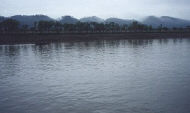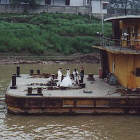The third and final day on the river indeed dawned overcast and drizzly. I was once again up and about at 6:30am and despite the gray and sunless morning the scenery was the most spectacular of the passage. Whisks of low cloud surrounded the peaks of nearby hill tops, flowing like misty waterfalls into the valleys. A lone fisherman tended his nets on the foreshore, his tiny sampan beached amongst tall reeds on a sandy little beach as we passed.
The colours of the morning, dull and gray compared with those of the previous day, were more than made up for by the dramatic mood created by the combination of river, hills and cloud. It made for great photographs.
After breakfast, though, the spell was sharply broken as a combination of rainy mist and oily smog engulfed all but the most obscure outlines of surrounding scenery. Such a pity it was as the terrain in this part of the river was potentially the most beautiful.
![]()
![]()
![]()


![]()
![]()
Passing under the bridge at Jiujiang in Jiangxi province, we made a ten-minute stop at the city’s little port before sailing onwards.
We were now in tea-growing country. This region formed the hinterland of China’s vast tea crops, harvested and dispatched to all corners of the country to supply a national tea-drinking addiction. In the eighteenth and nineteenth centuries, after discovering for themselves how wonderful a drink it made, the Europeans had plied the water of the Yangzi with hundreds of impressive sailing ships, or tea-clippers. With each vessel tasked with getting their valuable cargoes of tea to Europe’s markets as quickly as possible, they must have made a majestic sight under full-sail as they raced away from loading ports like Wuhan or Jiujiang, destined for ports like London or Rotterdam.
By afternoon though, I was feeling depressed and disappointed at the scenery – or lack of it. I could at times even smell the oily stench of the smog.
![]()
![]()
![]()


![]()
![]()
We made our final stop at Huangshi, in Hubei province. It was quite a large city, squeezed between the river and the mountains, with even a couple of jagged hills jutting out of the suburbs themselves. It would have made for a spectacular photograph were it not for the blanket of smog which all but hid the sight from view. As the boat glided into the port, we interrupted a bride and groom from having their wedding photographs taken at the ferry terminal wharf. With numerous unintelligible shouts of encouragement from onboard, the couple and their photographer hastily packed away their things and escaped quickly up the long set of concrete steps that led from the river to the city above.
As we chugged along the final stretch of the river, time seemed to go very slowly. There was nothing to see outside, the television was all in Mandarin and I had finished the only book I had brought with us.
Darkness fell for the third time since departing Shanghai and I passed the time outside at the handrail on the bow. The air was clearer now and held no odor. I watched the lights of settlements pass by ashore. Gradually, these began to acquire a suburban feel – large neon signs for restaurants and karaoke bars began to pass by and the lights from houses became closer together and more numerous.
Finally, ahead of us, loomed the bright lights of Wuhan – China’s fourth largest city. We passed beneath the city’s new bridge, the seventh and last that we had encountered along the river. The ferry began to slow and gently coasted to a stop alongside Wuhan’s impressive new terminal complex, leaving us to haul our four heavy bags out of our cabin, down the central staircase and through the masses of Fifth Class passengers in the main foyer before exiting down the gangway to meet Weiping’s brother on the large floating jetty.
It had generally been a relaxing and fascinating three days on the Yangzi. While the final day had been a disappointment, the first two had easily made up for it. From the Pacific Ocean, we had traveled a thousand miles upstream and it was an amazing thought that one could travel another thousand further inland to Chongqing in Sichuan province before the Yangzi River finally became too shallow and its flow too powerful for shipping to venture further.
Certainly we could have traveled this sector by train or commercial airliner, but by doing so we would have missed out on the rich tapestry of imagery that the Yangzi Valley holds within.
I felt, personally, that I had come to know my wife’s homeland that little bit better as a result.